
We are happy to announce that Interreg project “Joint management of Latvian – Lithuanian transboundary river and lake water bodies (TRANSWAT)” was launched this month.
The aim of TRANSWAT project is to ensure joint assessment and management of trans-boundary river and lake water bodies which hydromorphological and/or ecological quality pose a risk for not meeting the EU Water Framework Directive (WFD) requirements.
Three trans-boundary river basins (Venta, Lielupe and part of Daugava/Dauguva) are in the programme area where ecological status of many river and lake water bodies is below “good”. Moreover, some river bodies are designated as “heavily modified” due to substantially altered natural conditions – the result of flow regime regulation by hydro power plants (HPPs) cascades. Right now mainly in Latvia lakes located on cross-border area between Latvia and Lithuania are delineated as water bodies. Consequently, water quality monitoring and pressure analysis of these lakes is carried out primarily on Latvian side.
Project will address two main components: (1) assessment and management of rivers affected by HPP’s cascades and (2) estimation and management of trans-boundary lakes ecological status and ecosystem health.
First component will cover evaluation of ecological flow (E-flow) in trans-boundary rivers regulated by HPPs cascades within Venta River Basin and proposal of amendment to national water legislation for mitigation of impacts created by such river flow regulation. During the field surveys hydomorphological and fish data will be collected for E-flow modelling needs in Lithuania (Varduva River, 5 HPPs) and Latvia (Losis River, 2 HPPs and Ciecere River, 3 HPPs). After, the most popular model for E-flow calculations in line with WFD’s requirements (MesoHABSIM) will be used. TRANSWAT project will use E-flow modeling harmonized approach previously developed by project “ECOFLOW”. As well the project will perform E-flow calculations in web-based modelling platform which will be created by recently started LIFE GoodWater IP project. Based on E-flow assessment results, the modeling of HPP operations in cascade will be done using HEC-RAS model (a computer program that models the hydraulics of water flow through natural rivers and other channels) to ensure the ecological regime downstream of each HPP and sustainable water resource management in general. Finally, an amendment to national water legislation for mitigation of impacts created by river flow regulation will be proposed based on developed results and recommendations.
Second component will assess ecological status of five trans-boundary lakes located in Lielupe (Gaiaris/Ilgė) and Daugava/Dauguva (Galinu/Salna, Kumpinisku/Kampiniskiai, Lauceses/Laukesas and Skirnas) river basins. Three lakes (Galinu/Salna, Kumpinisku/Kampiniskiai, Lauceses/Laukesas) are a part of NATURA 2000 network. New data will be gathered during water quality and quantity monitoring, and detailed biological and fish surveys. Then, combining new data with in depth analysis of lake catchments (such as identification of possible surface water and groundwater interaction and mathematical procedures for identification and quantification of pollution sources) the ecological status of five lakes will be evaluated. As well new joint methodology for lake ecosystem health assessment will be developed and then tested in pilot area – Garais/Ilgė lake. Finally, harmonized Latvia-Lithuania monitoring program (MP) and Program of Measures (PoM) will be established to ensure sustainability of project results and further improvement of water quality.
Project duration period: 01.10.2020 – 30.09.2022
Project No.: LLI-533
Project acronym: TRANSWAT
Project budget: the total project budget 607 466.51 EUR (ERDF – European Regional Development Fund co-financing 516 346.53 EUR)
Project is financed by: Latvian–Lithuanian cross-border cooperation Programme 2014–2020. http://www.latlit.eu/
Official EU website: www.europa.eu
__
The contents of this publication are the sole responsibility of Lithuanian Energy Institute and can under no circumstances be regarded as reflecting the position of the European Union.






